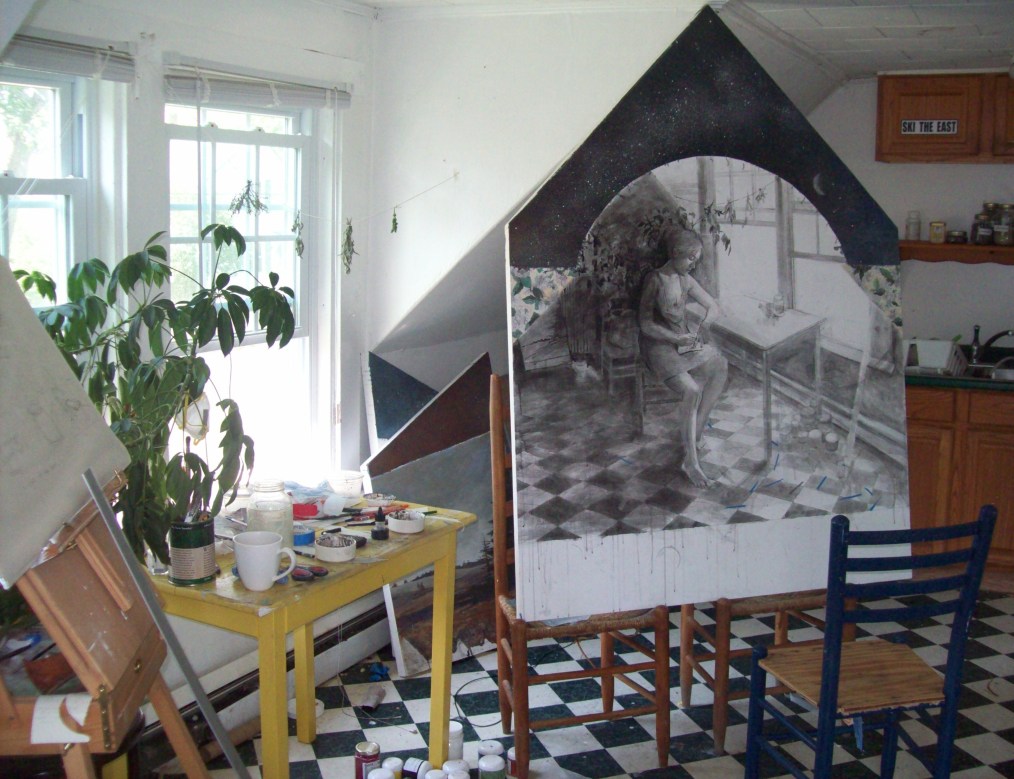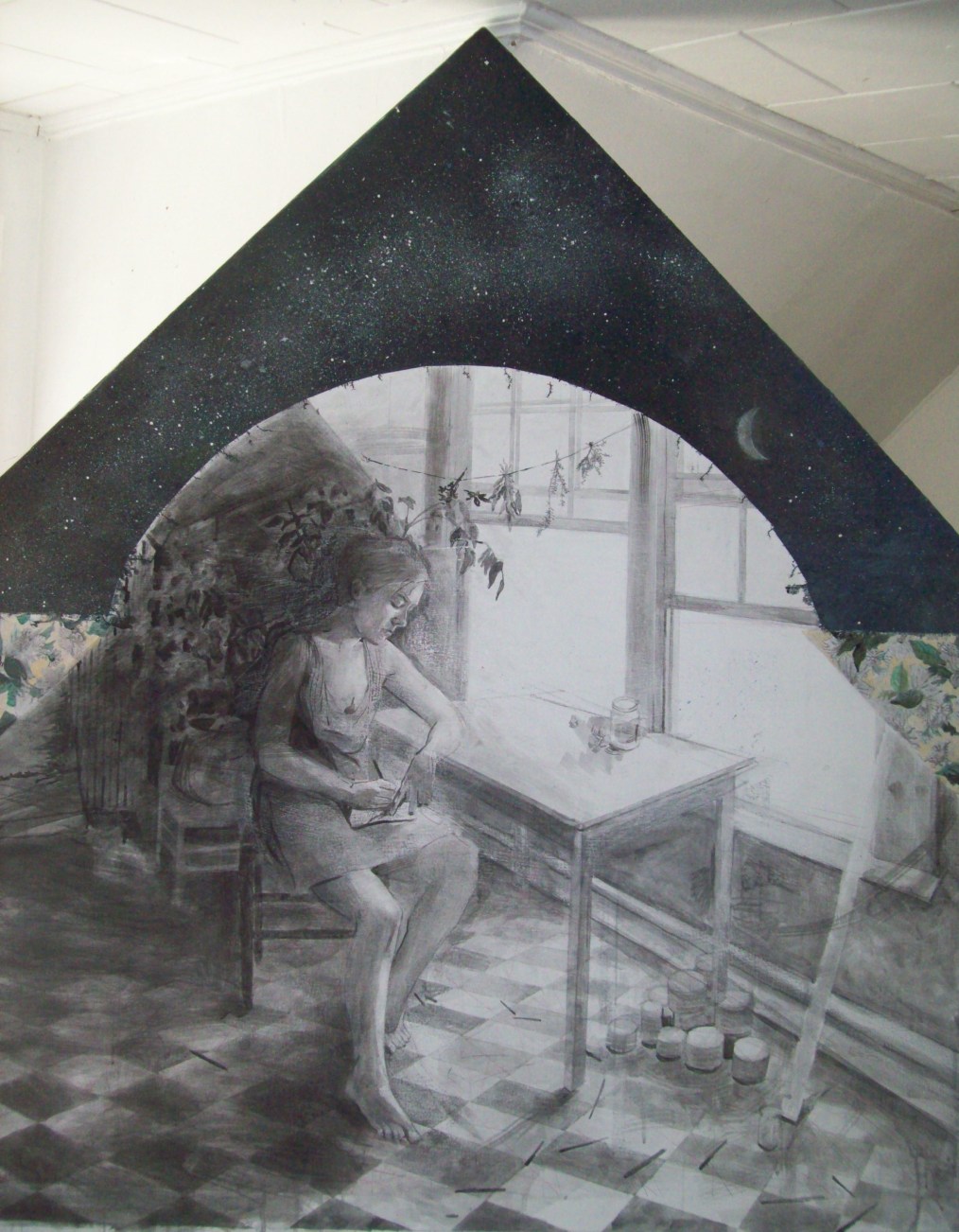“What is high for the cello is low for the violin, and the violin shows its special character in a region which the cello can hardly achieve.” Thompson 4
Like instruments, painting mediums posses differing characteristics which a painter may find more or less suitable for her purposes. It is advisable to both work in media that suit one’s sensibilities and use the natural range of that media to one’s advantage. Thusfar I have experimented with oil, acrylic, casein, watercolor, fresco, and egg tempera paints. Oil, watercolor, and tempera are the only three I have any decent experience in, and at this time I find egg tempera most suited to my sensibilities.
The natural range of egg tempera is somewhat limited compared to acrylic or oil paint. Oil paint has been the most common paint for the last 500 years. Ralph Mayer wrote that there are “nearly as many techniques and combinations of techniques in oil painting as there are schools of artistic thought.” (196) Acrylic painting, though newer, brings with it a vast range of mediums designed to create any effect. Egg tempera is certainly more limited, but these limitations also bring strengths that neither acrylic nor oil paints can provide. Oil and acrylic techniques will in most cases produce paintings that are fleshy, vibrant, and blended. They can easily mimic great depth and capture darks very well. Egg tempera falters in the darker values and therefore is less adept at mimicking depth and form. It is difficult to evenly blend and colors will often appear muted, even chalky and dry in the highest values. However, its sublety in those same high values is unparelled. The rigidity of the paint requires an application technique which will produce a beautifully mottled surface. Lastly, its reticence to mimic form and depth allows for a more contemplative naturalism, enabling greater symbolic possibilities and inviting the viewer to immediately engage on a reflective and intellectual level.
I was not aware of these benefits when I first started painting in egg tempera. I became interested in the medium a year ago while in Italy, but only began to paint in it last Spring. Egg tempera ideally requires two lifetimes and a shopfull of assistants to master, so I am only beginning to discover its possibilities. At first, I wanted to paint in it only because I thought it was beautiful and simple.
And it is beautiful! But it is not simple. What it is, is pure—only pigment and yolk—and craftable to the artists own requirements. Within that craftability there is room for infinite variation. In producing paint one can be very scientific or rather loose. I lean towards loose. Though some painters add vinegar, clove oil, or alcohol to their paints, I follow the basic egg-water-pigment formula.
The egg yolk here is the medium. Mediums have four functions in painting: executive, binding, adhesive, and optical. The executive function keeps the pigment in line, allows it to be applied and spread out on the substrate. If this were the only function of the medium, water would suffice. The second function, binding, is what gives the medium its second common name, “binder”. This is the function wherein the pigment particles are locked into a thin film, protecting them from both the atmosphere and the subsequent coats of paint. Egg yolk is an emulsion, a stable mixture of an aqueous liquid with a fatty substance. Hen’s eggs are comprised of a gummy subststance, albumen, egg oil, and the stabilizing lipoid lecithin (Mayer 266). These elements in combination cause a cooked egg to congeal and have the same effect when mixed into paint, applied in a thin film, and exposed to the air. The third function, adhesive, is related to the binding—the film must not only be secure in itself but secure in attaching to the ground. The last function, the optical is minimized in tempera painting. Whereas an oil medium will emphasize different characteristics in different pigments with its shine, dried egg yolk does not have any refraction properties of its own and will allow the pigment to fail or succeed on its own merit.
Pigments are pigments, no matter in what medium they are applied. They come from the earth and from laboratories in the form of soil, minerals, metals, and synthetic chemicals. All of these differing sources follow the same path—they are ground into a fine powder and then combined with the medium. I order pigments in the powder form and combine them with my yolk—which is from a free range egg, it really does make a difference. Vastly differing palletes (selections of colors) are recommended by different sources which goes to show that it does not matter what you use as long as you use it consistently and in the right combinations. The pallete I have been using is a haphazard collection of about ten tubs of powder and a small pile of watercolor tubes (high quality watercolor paints are almost pure pigment and are commonly used by tempera painters in combination with yolk. I use them for colors which are too hazardous, such as cadmium, or too expensive, like viridian, to buy in bulk powder form.)The pigments I use most are: Mars black, titanium white, burnt umber, burnt sienna, venetian red, mayan red, cadmium red medium, cadmium orange, yellow ochre, medium yellow sun, hookers green, sap green, viridian, cerulean blue, ultramarine, mayan blue, paynes grey, and an unrefined lapis grey. This is a lovely range of colors that I occasionally expand upon.
I mix the paint only as I need, because it will not keep. People always ask if egg tempera smells, and yes, it definitely smells. It does not smell at all when dry but the medium ranges from a wet eggy smell to a sulfurous rotten one if it is not stored in the fridge or used quickly enough. Thus, I never have a full palate in front of me, but only the color or several colors I am working from at one time. The paints are mixed in little porcelain cups and then used immediately. I use a wide variety of brushes, although the most useful ones are soft and small. Sometimes I will even splatter the paint with a toothbrush or dab it with a sponge. Egg tempera is translucent and must be applied in many thin layers, slowly building up highlights and glazing down shadows. It lends itself to a hatching motion, and will produce a beautiful surface if applied patiently. It is certainly a medium which has captured my heart.













